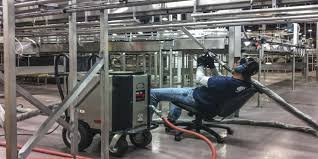Why industries are turning to dry ice blasting for modern maintenance
Introduction
Industrial cleaning is an essential part of keeping operations safe, efficient, and compliant. However, many traditional cleaning methods—such as water blasting, chemical solvents, and abrasive media—create challenges like residue, damage to surfaces, or downtime due to disassembly. As businesses search for faster, cleaner, and more sustainable alternatives, dry ice blasting has become a preferred solution in a wide range of industries.
Dry ice blasting uses the power of compressed air and frozen carbon dioxide to remove contaminants from equipment, surfaces, and production environments. Its growing popularity stems from its ability to clean thoroughly without moisture, chemicals, or physical abrasion.
How dry ice blasting works
Dry ice blasting involves propelling small pellets of solid CO₂ at high velocity toward a surface. These pellets are extremely cold, reaching temperatures as low as -78.5°C. When they hit the target surface, three cleaning effects happen almost simultaneously:
- The impact of the pellet dislodges dirt, grease, or buildup.
- The intense cold causes the contaminants to contract and break apart.
- The dry ice sublimates—instantly turns from solid to gas—creating a rapid expansion that lifts debris from the surface.
Because the dry ice disappears on contact, there is no secondary waste. The only cleanup needed is for the dislodged particles, which can be vacuumed or swept away.
Common uses across industries
Dry ice blasting is used across a wide variety of sectors because it can be safely applied to both delicate and heavy-duty equipment. Some of its most common applications include:
Food processing
The food industry requires extremely high hygiene standards, and dry ice blasting offers a non-toxic, non-residue method of cleaning. It’s used to remove grease, protein buildup, sauces, and baked-on residues from machinery like ovens, conveyors, and mixers—without using water or disassembly.
Automotive manufacturing
Dry ice blasting is used to clean engine parts, robotic equipment, painting booths, and molds. Its non-abrasive nature means sensitive components and surfaces are not damaged, and production lines can often continue with minimal interruption.
Plastics and rubber industries
Injection molds in these industries accumulate buildup over time. Dry ice blasting cleans molds without damaging precision surfaces or requiring extended downtime, which keeps productivity high.
Aerospace and electronics
This method is ideal for precision cleaning of electronic panels, circuit boards, turbine blades, and other aerospace components that cannot tolerate moisture or abrasives.
Restoration and remediation
In disaster recovery or historical preservation, dry ice blasting is used to remove soot, smoke damage, mold, and old paint without harming underlying wood, brick, or stone.
Benefits of dry ice blasting
Several factors contribute to the growing adoption of dry ice blasting in industrial and commercial cleaning:
- No water or chemicals are used, making it suitable for sensitive environments.
- There is no abrasive action, so surfaces are left intact.
- No secondary waste is created, reducing cleanup time.
- Equipment can often be cleaned in place, cutting downtime.
- It is safe for electrical components and wiring when used with proper care.
- The process is environmentally friendly, using reclaimed CO₂ that does not add new emissions.
In many cases, companies see improved equipment performance, reduced maintenance intervals, and fewer disruptions to production schedules.
Limitations to consider
Despite its advantages, dry ice blasting has a few limitations. The equipment and regular supply of dry ice pellets require an upfront investment. The dry ice must be stored in insulated containers, and since it sublimates over time, planning is important to avoid waste.
The method is also less effective on very thick or sticky materials unless combined with other cleaning methods. In enclosed spaces, proper ventilation is necessary, as CO₂ displaces oxygen and could pose a risk if not managed correctly.
Additionally, the process can be noisy, and operators must be trained in handling high-pressure equipment and extremely cold materials safely.
Environmental and operational advantages
Dry ice blasting aligns well with growing environmental regulations and workplace safety standards. Unlike solvent-based cleaning, it does not produce hazardous waste, and there are no chemical residues to dispose of. CO₂ used in the process is usually captured from existing industrial emissions, so the environmental impact is minimal.
For companies aiming to reduce their ecological footprint while maintaining efficiency, dry ice blasting offers a practical path forward.
Conclusion
Dry ice blasting is a modern cleaning solution that meets the demands of today’s industrial operations. With its ability to clean effectively without water, chemicals, or surface damage, it has become a valuable tool in maintaining equipment, improving efficiency, and supporting sustainability goals.
As more businesses discover its benefits, dry ice blasting is expected to become a routine part of maintenance and cleaning strategies in manufacturing, food production, restoration, and beyond. It’s not just an alternative—it’s a significant upgrade in how industries approach cleanliness and care.




